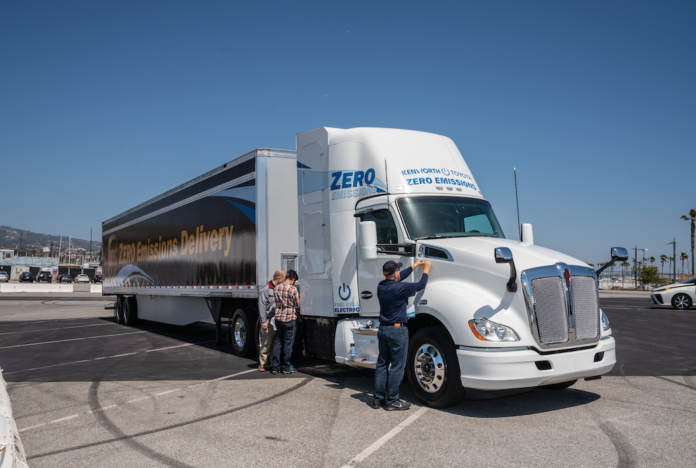The California Air Resources Board (CARB) has adopted a first-in-the-world rule – the Advanced Clean Truck regulation – that requires truck manufacturers to transition from diesel trucks and vans to electric zero-emission trucks beginning in 2024. By 2045, every new truck sold in California will be zero-emission.
This move sets a clean-truck standard for the nation and the world and marks Gov. Gavin Newsom’s most significant air pollution regulation to date. It zeroes in on air pollution in the state’s most disadvantaged and polluted communities.
“California is going electric. We are showing the world that we can move goods, grow our economy and finally dump dirty diesel,” says Jared Blumenfeld, secretary for environmental protection in California.
Many California neighborhoods are adjacent to ports, rail yards, distribution centers and freight corridors and experience the heaviest truck traffic. This new rule directly addresses disproportionate risks and health and pollution burdens affecting these communities and puts California on the path for an all zero-emission short-haul drayage fleet in ports and rail yards by 2035, and zero-emission “last-mile” delivery trucks and vans by 2040.
Trucks are the largest single source of air pollution from vehicles, responsible for 70% of the smog-causing pollution and 80% of carcinogenic diesel soot, even though they number only 2 million among the 30 million registered vehicles in the state.
This requirement to shift to zero-emission trucks, along with the ongoing shift to electric cars, will help California meet its climate goals and federal air quality standards, especially in the Los Angeles region and the San Joaquin Valley – areas that suffer the highest levels of air pollution in the nation. Statewide, the Advanced Clean Truck regulation will lower related premature deaths by 1,000.
The announcement, however, drew criticism from some clean-fuel groups.
“This rule is incomplete without an addition to the definition of ‘near-zero-emission vehicle,’ or NZEV, to include the currently certified low NOx 0.02-gram engine, and corresponding changes to the NZEV credit provisions, such that near-term air quality benefits are incentivized in this rulemaking,” says Sherrie Merrow, director of the state of affairs at NGVAmerica. “Since tailpipe emissions in the California transportation sector continue to increase, it is imperative that all appropriate available measures be taken to reverse this trend.
“Engines utilizing renewable natural gas (RNG) are available today for every medium- and heavy-duty application, and their increased deployment will immediately reduce emissions,” she adds. “These vehicles are potentially carbon-neutral and even carbon-negative depending on the RNG source. And they are most affordable with a mature, established refueling infrastructure already in place, meaning more vehicles on the road sooner at less public cost. Without this addition to the NZEV definition, how does this regulation achieve near-term air quality and immediate public health benefits? It will be decades before its impact is felt, if ever. Other states, spending less and using all appropriate technologies available today, have successfully reduced emissions immediately in concert with the promotion of new technologies for the future.”
The rule drives technology and investment, phasing in available heavy-duty zero-emission technology starting in 2024 with full transformation over the next two decades. This sends a clear signal to manufacturers, fleet owners and utilities that the time to invest in zero-emission trucks – and the economy – is now.
In the coming months, CARB will also consider two complementary regulations to support the recent action. The first sets a stringent new limit on nitrogen oxides (NOx), one of the major precursors of smog. This will require that new trucks that still use fossil fuels include the most effective exhaust control technology during the transition to electric trucks. There is also a proposed requirement for larger fleets in the state to transition to electric trucks year over year.
“Even as CARB contemplates mandates for zero-emissions vehicles, diesel technology in commercial vehicles will continue to play an important role in California and the nation’s economy for decades to come,” says Allen Schaeffer, executive director of the Diesel Technology Forum.
“Diesel is the technology of choice for America’s trucking industry because of its unique combination of features: the most energy efficient internal combustion engine, power density, driving range, reliability, durability and widely available fueling, servicing and parts networks. Continuous improvement that has now achieved near-zero emissions, improving energy efficiency and capabilities of using low-carbon renewable biodiesel fuels, ensure diesel’s place in the future,” he adds.
CARB’s recent action was preceded by multiple regulations to transition to zero-emission passenger cars, cleaner diesel fuel and improved technologies to limit diesel emissions for all trucks and buses. Over the past few years, CARB has also set rules to electrify buses used by transit agencies and shuttles at the state’s largest airports by 2030.
Photo: A zero-emission UPS delivery truck







